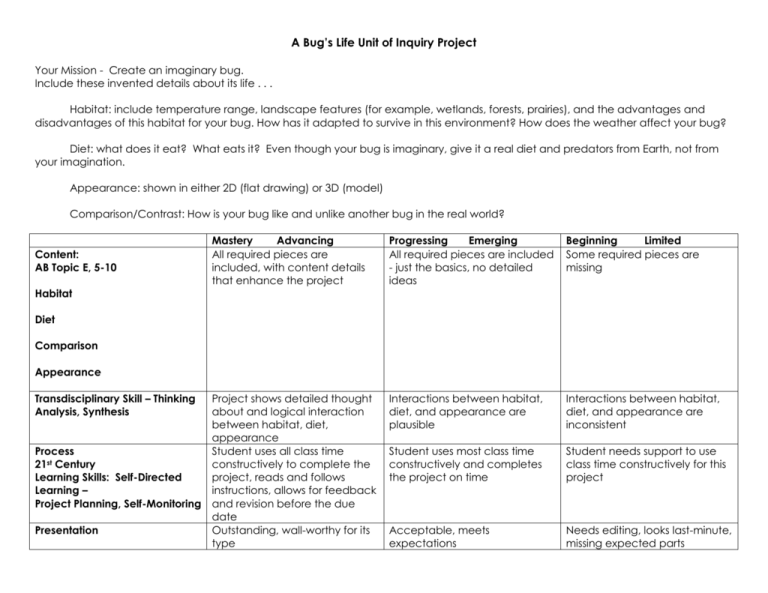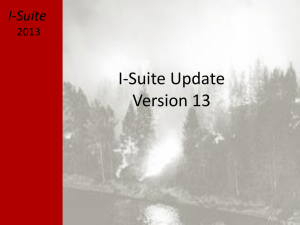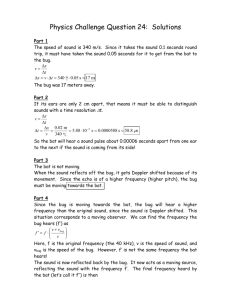A-Bugs-Life-Project-Fall
advertisement

A Bug’s Life Unit of Inquiry Project Your Mission - Create an imaginary bug. Include these invented details about its life . . . Habitat: include temperature range, landscape features (for example, wetlands, forests, prairies), and the advantages and disadvantages of this habitat for your bug. How has it adapted to survive in this environment? How does the weather affect your bug? Diet: what does it eat? What eats it? Even though your bug is imaginary, give it a real diet and predators from Earth, not from your imagination. Appearance: shown in either 2D (flat drawing) or 3D (model) Comparison/Contrast: How is your bug like and unlike another bug in the real world? Content: AB Topic E, 5-10 Mastery Advancing All required pieces are included, with content details that enhance the project Progressing Emerging All required pieces are included - just the basics, no detailed ideas Beginning Limited Some required pieces are missing Interactions between habitat, diet, and appearance are plausible Interactions between habitat, diet, and appearance are inconsistent Student uses most class time constructively and completes the project on time Student needs support to use class time constructively for this project Acceptable, meets expectations Needs editing, looks last-minute, missing expected parts Habitat Diet Comparison Appearance Transdisciplinary Skill – Thinking Analysis, Synthesis Project shows detailed thought about and logical interaction between habitat, diet, appearance Process Student uses all class time 21st Century constructively to complete the Learning Skills: Self-Directed project, reads and follows Learning – instructions, allows for feedback Project Planning, Self-Monitoring and revision before the due date Presentation Outstanding, wall-worthy for its type Content: AB Topic E, 5-10 Habitat Diet 6 Includes all required pieces and creative content details that enhance the project 5 Includes all required pieces and a creative content detail that enhances the project 4 Includes all required pieces in each category 3 Missing 1-2 required pieces 2 Missing 3-4 pieces; not much detail in each category 1 More than 4 pieces are missing Demonstrates superior understianding about the interaction between habitat, diet, weather, and bug traits Outstanding use of class time – seeks help when appropriate, applies thoughtful revision to project before due date + 4, 5 Demonstrates superior understianding about the interaction between habitat, diet, Clearly explains the interactions between diet, habitat, weather, and bug traits Information fits together logically Some pieces do not fit together logically Shows understanding of just one facet No understanding of diet, weather, habitat, or appearance is indicated by this project Meets minideadlines for the project; leaves time before the due date for feedback and revision + 4 Uses class time constructively to develop project; completes it on time Needs some support to work productively in class; completes project on time Needs some support to work productively in class; does not complete project on time Needs lots of support to work productively in class; does not complete project on time Clearly explains the interactions between diet, habitat, weather, and bug traits Information fits together logically Some pieces do not fit together logically Shows understanding of just one facet No understanding of diet, weather, habitat, or appearance is indicated by this project Comparison Appearance Demonstrates Understanding: Transdisciplinary Skill – Thinking Analysis, Synthesis Process 21st Century Learning Skills: Self-Directed Learning – Project Planning, Self-Monitoring Presentation weather, and bug traits 4 3 2 1 Content-Habitat Landscape features and temperature ranges are included, with at least two logical advantages and two disadvantages Landscape features and temperature ranges are included without advantages and disadvantages Landscape features or temperature are mentioned Content—Food Chain Logical choices for both what the bug eats and what eats it, given the selected habitat and the bug’s appearance Include at least three logical ways the bug has adapted to its environment The drawing or model of the bug includes many thoughtful details, is eye-catching and unpredictable but still logical Landscape features and temperature ranges are included; fewer than 4 advantages and disadvantages or there are 4 but they aren’t all logical What the bug eats and what eats it are mentioned, but one choice or the other isn’t logical due to the bug’s habitat or appearance Include at least two logical ways the bug has adapted to its environment Only one idea is listed for what the bug eats and only one idea is listed for what eats the bug Includes one logical way the bug has adapted to its environment The drawing or model of the bug includes one or two thoughtful details and looks appropriate for a bug Some sentences are confusing; more than 3 mechanical errors; organization needs improvement What the bug eats or what eats the bug is missing Content-Adaptations Presentation – Artistic Effect Presentation – Clarity of Writing Clearly written sentences, perfect written mechanics, excellent written organization The drawing or model of the bug includes some thoughtful details and looks appropriate for a bug Almost all sentences are clearly written and error-free; writing is logically organized Includes only illogical ideas about the bug’s adaptation to its environment The drawing or model of the bug looks appropriate for a bug and may be eye-catching, but does not include thoughtful details It is difficult to understand the writing Presentation – Overall Effect Writing and artwork are combined effectively, details and creative touches enhance the project Creative touches improve the project The creative touches are distracting from the project No creative touches were added








